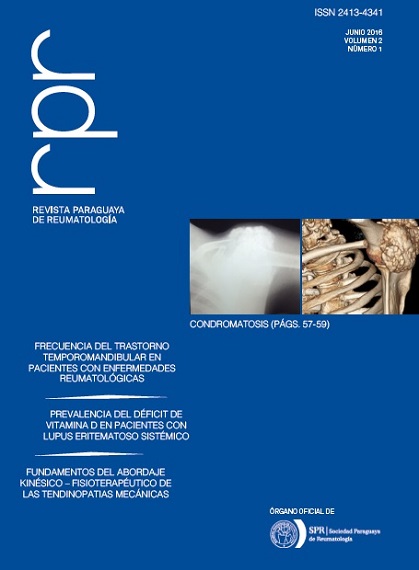Prevalence of vitamin d deficiency in patients with systemic lupus erythematosus from the rheumatology service of Hospital de Clínicas
Abstract
Introduction: Systemic Lupus Erythematosus (SLE) is a systemic inflammatory disease associated with genetic, environmental, hormonal and immunological factors. One possible factor is the deficiency of vitamin D. Vitamin D is a hormone that has a significant number of functions and actions in various physiological processes in the body and has a very important role in the immune system. Therefore prevalence of vitamin D deficiency has been linked to the severity of autoimmune diseases such as SLE. Objectives: To determine the prevalence of insufficiency and deficit of vitamin D in patients with SLE at follow up in the Rheumatology Department at the “Hospital de Clínicas”. Methods: Observational Trial, analytically based on the record of epidemiological data (i.e. sex and age) and clinical ( i.e. treatment with supplements) and the determination of concentrations of vitamin D and the phospho-calcium metabolism parameters of patients diagnosed with SLE. A vitamin D deficiency is determined as values less than 30 ng /dl. The dosage of vitamin D was performed by chemiluminescence with ARCHITEC. This trial is a preliminary analysis that is part of a project supported by CONACYT on the role of vitamin D in patients with SLE. Results: We included 77 patients, of whom 94.8 % (73/77) were female. The average age of patients at the time the study was 28.9 ± 8.20 years. All patients received calcium supplements associated with vitamin D. 29.87 % (23/77) of patients had a deficiency of vitamin D, the average value of the concentration thereof 32.2 ± 13.40 ng /ml. 94.8 % (73/77) of the population had normal serum calcium and the total population had a normal phosphoremia. As for the dosage of PTH, it was found that 27.3 % (21/77) have high values of PTH. Conclusion: In this cohort of patients with SLE, a significant percentage of patients with vitamin D deficiency was observed, despite their receiving supplements. This is a preliminary analysis that is part of a project studying the role of vitamin D in SLE and as a basis to create recommendations on the use of vitamin supplements as part of the therapeutic arsenal for this disease.
Downloads
References
(1) Mok CC, Lau CS. Pathogenesis of systemic lupus erythematosus. J Clin Pathol. 2003;56:481-490.
(2) D’ Crux DP, Khamashta MA, Hughes GR. Systemic lupuserythematosus. Lancet. 2007;369(9561):587-96.
(3) Li PH, Hing W, Wong S, et al. Relationship between autoantibody clustering and clinical subsets in SLE: Cluster and association analyses in Hong Kong Chinese. Rheumatology (Oxford). 2013; 52:337-345.
(4) Uva L, Miguel D, Pinheiro C, Freitas JP, Marques Gomes M, Filipe P. Cutaneous manifestations of systemic lupus erythematosus. Autoimmune Dis. 2012;2012:834291.
(5) Holick MF (2004) Sunlight and vitamin D for bone health and prevention of autoimmune diseases, cancers, and cardiovascular disease. Am J Clin Nutr. 80:1678S-1688S
(6) Vinh qu c Lu‘o‘ngK, Nguy n LT (2013) The beneficial role of vitamin D in obesity: possible genetic and cell signaling mechanisms. Nutr. J12:89
(7) HolickMF (2007) Vitamin D deficiency. N Engl JMed. 357:266-281
(8) GrantWB (2006) Epidemiology of disease risks in relation to vitamin D insufficiency. Prog Biophys Mol Biol. 92:65-79.
(9) Baeke F, Takiishi T, Korf H, Gysemans C, Mathieu C (2010) Vitamin D: modulator of the immune system. Curr Opin Pharmacol. 10:482-496.
(10) Arnson Y, Amital H, Shoenfeld Y (2007) Vitamin D and autoimmunity: new aetiological and therapeutic considerations. Ann Rheum Dis. 66:1137-1142.
(11) Adorini L, Penna G (2008) Control of autoimmune diseases by the vitamin D endocrine system. Nat Clin Pract Rheumatol. 4:404-412.
(12) Daniel C, Sartory NA, Zahn N, Radeke HH, Stein JM(2008) Immune modulatory treatment of trinitrobenzene sulfonic acid colitis with calcitriol is associated with a change of a T helper (Th) 1/Th17 to a Th2 and regulatory T cell profile. J Pharmacol Exp Ther. 324:23-33.
(13) Lemire JM, Ince A, TakashimaM(1992) 1,25-Dihydroxyvitamin D3attenuates the expression of experimental murine lupus of MRL/l mice. Autoimmunity. 12:143-148.
(14) O‘Regan S, Chesney RW, Hamstra A, Eisman JA, O‘Gorman AM,Deluca HF (1979) Reduced serum 1,25-(OH)2 vitamin D3 levels in prednisone-treated adolescents with systemic lupus erythematosus. Acta Paediatr Scand. 68:109-111.
(15) Sakthiswary R, Raymond AA (2013) The clinical significance of vitamin D in systemic lupus erythematosus: a systematic review. PLoS One. 8:e55275.
(16) Kamen DL, Aranow C (2008) The link between vitamin D deficiency and systemic lupus erythematosus. Curr Rheumatol Rep. 10:273-280.
(17) Bonakdar ZS, Jahanshahifar L, Jahanshahifar F, Gholamrezaei A (2011) Vitamin D deficiency and its association with disease activity in new cases of systemic lupus erythematosus. Lupus. 20:1155-1160.
(18) Oneil S, Cervera R. Sistemyc Lupus erythematosus. Best Prac Res Clin Rheumatol. 2010;24(6):841-55.
(19) Souto, M. I. D., Coelho, A., Guo, C., Mendonça, L. M. C., Argolo, S., Papi, J. A. S., & Farias, M. L. F. (2011). Vitamin D insufficiency in Brazilian patients with SLE: prevalence, associated factors, and relationship with activity. Lupus. 20(10),1019-1026.
(20) Ross AC, Manson JE, Abrams SA, Aloia JF, Brannon PM et al (2011) The 2011 report on dietary reference intakes for calcium and vitamin D from the Institute of Medicine: what clinicians need to know. J Clin Endocrinol Metab. 96:53-58.
(21) Monticielo OA, Teixeira TM, Chies JA, Brenol JC, Xavier RM (2012) Vitamin D and polymorphisms of VDR gene in patients with systemic lupus erythematosus. Clin Rheumatol. 31:1411-1421.
(22) Costenbader KH, Feskanich D, Holmes M, Karlson EW, Benito- Garcia E (2008) Vitamin D intake and risks of systemic lupus erythematosus and rheumatoid arthritis in women. Ann Rheum Dis. 67:530-535.
Copyright (c) 2016 Paraguayan Journal of Rheumatology

This work is licensed under a Creative Commons Attribution 4.0 International License.









